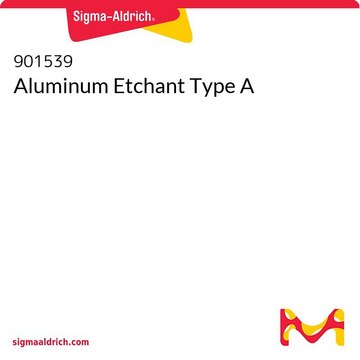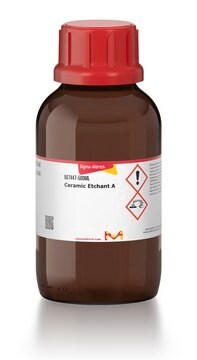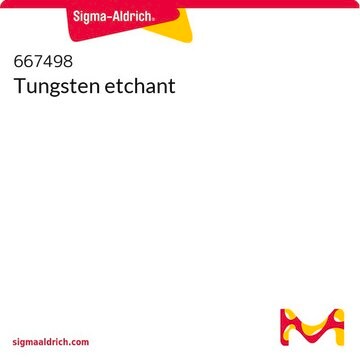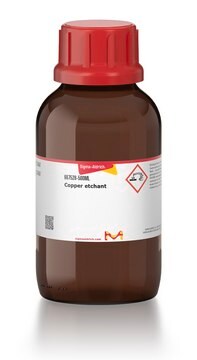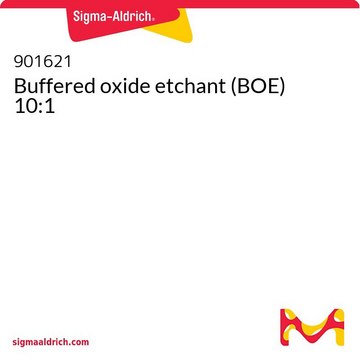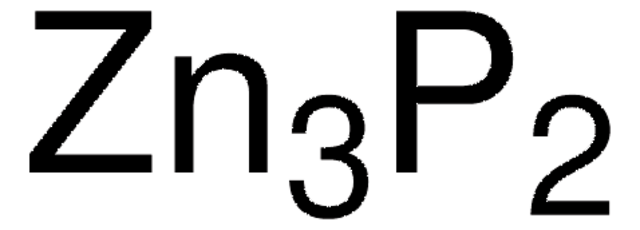901545
Aluminum Etchant Type D
Synonim(y):
Roztwór trawiący aluminium do stosowania w urządzeniach z arsenku galu i fosforku galu
Zaloguj sięWyświetlanie cen organizacyjnych i kontraktowych
About This Item
Kod UNSPSC:
12352311
NACRES:
NA.23
Polecane produkty
Formularz
liquid
Opis ogólny
WYTRAWIACZ DO ALUMINIUM - TYP D
- Standardowy wytrawiacz aluminiowy do stosowania na urządzeniach z arsenku galu, arsenku i fosforku galu oraz do metalizacji aluminium na rezystorach nichromowych.
- Wytrawiacze do aluminium to stabilne, nietoksyczne preparaty stosowane do wytrawiania metalizacji aluminiowych na urządzeniach krzemowych i w układach scalonych. Kontakty aluminiowe są definiowane i tworzone są połączenia. Te wytrawiacze do aluminium, opracowane z unikalnymi właściwościami, z łatwością pokonują wiele trudności napotykanych w procesach wytrawiania aluminium.
- Proces metalizacji i trawienia aluminium przy użyciu technik fotolitograficznych jest podstawą technologii półprzewodnikowej i mikroelektronicznej. Wytrawiacze do aluminium są wysoce kompatybilne z komercyjnymi fotorezystami i umożliwiają tworzenie wzorów o wysokiej rozdzielczości. Możliwe są linie metalowe o szerokości 1 milimetra i separacje mniejsze niż 5 mikronów. Wysoka rozdzielczość jest praktyczna w przypadku tych wytrawiaczy aluminiowych, ponieważ nie występuje podnoszenie wzorów fotorezystu, a podcinanie jest zminimalizowane. Co więcej, wytrawiacze nie atakują krzemu, dwutlenku krzemu, azotku krzemu ani nichromowych folii rezystorowych.
- Do użytku w mikroelektronice oferowane są dwa wytrawiacze aluminiowe. Typ A jest zalecany do stosowania na urządzeniach krzemowych. Typ D jest zalecany do stosowania na urządzeniach z arsenku galu i fosforku galu, aby uniknąć ataku wytrawiacza na związek międzymetaliczny. Jest on również zalecany do wytrawiania aluminiowych metalizacji na nichromowych rezystorach cienkowarstwowych.
Zastosowanie
- Metalizacje aluminiowe do 25 000 Å są osadzane próżniowo na plastrze krzemu, powlekane fotorezystem i naświetlane promieniami UV przy użyciu odpowiedniej maski fotograficznej. Opornik jest opracowywany w celu ochrony aluminium w miejscach, w których pożądane są połączenia. Następnie niezabezpieczone obszary aluminium są usuwane poprzez trawienie za pomocą wytrawiacza do aluminium, a następnie płukanie wodą.
- Czas trawienia zależy od temperatury wytrawiacza i grubości warstwy aluminium. Podczas wytrawiania grubych folii aluminiowych wymagana jest wyższa szybkość wytrawiania; dlatego należy stosować wyższą temperaturę wytrawiacza. Podobnie, w przypadku cieńszych folii aluminiowych, pożądane jest wolniejsze tempo trawienia i należy wybrać niższą temperaturę wytrawiania.
- Przy określonej temperaturze wytrawiania, czas wytrawiania jest określony następującym wzorem:
gdzie Szybkość wytrawiania przy 25°C 30 Å/s; przy 40°C 80 Å/s.
Cechy i korzyści
- Kontrolowana szybkość trawienia
- Selektywne trawienie: nie atakuje SiO2 ani Si3N4
- Oferuje wysoką rozdzielczość przy minimalnym podcięciu
- Eliminuje powstawanie smug
- Ekonomiczny; wielokrotnego użytku
Ta strona może zawierać tekst przetłumaczony maszynowo.
Hasło ostrzegawcze
Danger
Zwroty wskazujące rodzaj zagrożenia
Zwroty wskazujące środki ostrożności
Klasyfikacja zagrożeń
Acute Tox. 4 Oral - Eye Dam. 1 - Met. Corr. 1 - Skin Corr. 1B - Skin Sens. 1
Kod klasy składowania
8A - Combustible corrosive hazardous materials
Klasa zagrożenia wodnego (WGK)
WGK 1
Temperatura zapłonu (°F)
Not applicable
Temperatura zapłonu (°C)
Not applicable
Wybierz jedną z najnowszych wersji:
Masz już ten produkt?
Dokumenty związane z niedawno zakupionymi produktami zostały zamieszczone w Bibliotece dokumentów.
Nasz zespół naukowców ma doświadczenie we wszystkich obszarach badań, w tym w naukach przyrodniczych, materiałoznawstwie, syntezie chemicznej, chromatografii, analityce i wielu innych dziedzinach.
Skontaktuj się z zespołem ds. pomocy technicznej